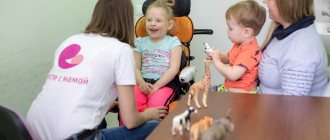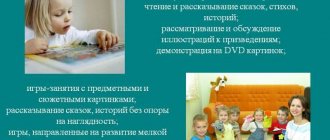Individual correctional and developmental route for a child with special needs development
Individual correctional and developmental route No. 1
Goal:
Correction of speech disorders in children, taking into account the individual characteristics of the child’s development (senior group)
Objective : Children’s mastery of independent, coherent, grammatically correct speech and communication skills, the phonetic system of the Russian language, elements of literacy
| Chapter speech development | Problem | Solution | |
| 1 | Sound pronunciation Articulation and fine motor skills Breath. | Several groups of sounds are broken Makes numerous mistakes in pronunciation of words. There are significant disturbances in the syllabic structure of words (simple and complex structure). Articulation and fine motor skills are not developed. Breathing is shallow, inhalation and exhalation are shortened. | Preparatory stage for producing sounds: articulation and breathing exercises. Stage of production of disturbed sounds. Step-by-step automation of sounds. Work on the syllabic structure of the word. Development of fine motor skills. |
| 2 | Phonemic awareness. Sound analysis and synthesis | Phonemic hearing is undeveloped: it does not distinguish sounds from other sounds, syllables, or as part of a word. Does not differentiate sounds. Does not have the skills of sound analysis and synthesis. | Develop the ability to: identify a sound against the background of other sounds, syllables, as part of a word; differentiate sounds; perform sound analysis and synthesis of syllables and words. |
| 3 | Lexicon | Knows the names of objects, but does not know the names of individual parts. There are no generalizing concepts or antonym words in speech. The use of verbs and adjectives is limited to the everyday level. Confuses the names of body parts, colors, and geometric shapes. Does not correlate the number of objects with the number | Expand and activate the subject and verbal dictionary on lexical topics. Use possessive and relative adjectives. Introduce generalizing words into speech, teach the classification of objects by lexical topics. |
| 4 | Grammatical structure of speech | Does not have the skill of forming words using suffixes. Word formation and inflection skills are undeveloped Omits all prepositions in speech (or uses 1-2 inappropriately). Does not agree on parts of speech. | Formation of words of diminutive meaning. Education: noun plural from units; case forms of nouns, singular and plural verbs. in the present and passed time; adjectives with the meaning of correlation. Agreement of parts of speech in gender, number |
| 5 | Connected speech | Does not make (sometimes cannot repeat) a sentence. Doesn't have the skill to write a story based on a picture It does not compose a story based on a series of paintings, it is a description story. Can't retell the text The communicative function of speech is undeveloped (it is difficult to enter into dialogue, there is no monologue, elements of speech negativism, etc.) | Making proposals (based on a sample, based on a picture, based on a demonstration of actions (based on questions) Compiling short stories based on a sample, on questions, on a painting, a series of paintings, a descriptive story Development of the communicative function of speech, the formation of a positive attitude towards classes, the desire for verbal communication, etc. |
Individual correctional and developmental route No. 2
Goal:
Correction of speech disorders in children, taking into account the individual characteristics of the child’s development (senior group)
Objective : Children’s mastery of independent, coherent, grammatically correct speech and communication skills, the phonetic system of the Russian language, elements of literacy
| Chapter speech development | Problem | Solution | |
| 1 | Sound pronunciation Articulation and fine motor skills Breath. | 1-2 groups of sounds are disturbed. The sounds introduced by the speech therapist are not introduced into independent speech. Makes mistakes in pronunciation of words. There are disturbances in the syllabic structure of words (simple and complex structure). Underdevelopment of articulatory and fine motor skills. Breathing is uneven, inhalation and exhalation are shortened. | Consolidation of sounds given by a speech therapist in speech. Preparatory stage for producing impaired sounds: articulation and breathing exercises. Stage of production of disturbed sounds. Step-by-step automation of sounds. Work on the syllabic structure of the word. Development of fine motor skills. |
| 2 | Phonemic awareness. Sound analysis and synthesis | Underdeveloped phonemic awareness: makes mistakes when isolating a sound against the background of other sounds, syllables, or as part of a word. Errors in differentiating similar-sounding sounds. Sound analysis and synthesis skills are in their development stage. | Develop the ability to: identify a sound against the background of other sounds, syllables, as part of a word; differentiate sounds; perform sound analysis and synthesis of syllables and words. |
| 3 | Lexicon | Knows and names objects, parts of objects more often used in everyday life In speech there are generalizing concepts (limited to 3-4 lexical topics). He selects 4-5 antonym words with errors. Uses frequently used verbs and adjectives of everyday life in speech Makes mistakes when naming body parts, colors, and geometric shapes. Correlates the number of objects with a number with errors | Continue to expand and activate the subject and verbal dictionary on lexical topics. Use possessive and relative adjectives. Continue to introduce generalizing words into speech, teach the classification of objects by lexical topics. |
| 4 | Grammatical structure of speech | Makes many mistakes when forming words using suffixes. Word formation and inflection skills are in the formative stage. Uses 2-3 simple prepositions in speech. Makes mistakes in coordinating parts of speech. | Formation of words of diminutive meaning. Education: noun plural from units; case forms of nouns, singular and plural verbs. in the present and passed time; adjectives with the meaning of correlation. Coordination of parts of speech in gender, number, case. |
| 5 | Connected speech | Makes up a simple sentence (often with errors in agreement and use of prepositions). Builds a story using leading questions. Composes a story from simple sentences based on a series of pictures. Story-description, retelling - partially (based on the model, based on questions) Communicative function of speech at the stage of formation | Drawing up simple and complex sentences (based on a model, based on a picture, demonstrating actions (based on questions) Drawing up short stories based on a model, based on questions, based on a picture, a series of paintings, a descriptive story Development of the communicative function of speech, dialogic and monologue speech |
Individual correctional and developmental route No. 3
Goal:
Correction of speech disorders in children, taking into account the individual characteristics of the child’s development (senior group)
Objective : Children’s mastery of independent, coherent, grammatically correct speech and communication skills, the phonetic system of the Russian language, elements of literacy
| Chapter speech development | Problem | Solution | |
| 1 | Sound pronunciation Articulation and fine motor skills Breath. | All sounds are choreographed and automated; self-control in independent speech is not fully formed. There are disturbances in the syllabic structure of complex words. Articulatory motor skills are normal. Underdevelopment of breathing and fine motor skills is partially preserved. | Consolidation of the sounds set by the speech therapist in the child’s coherent, independent speech. Work on the syllabic structure of complex words. Development of fine motor skills and breathing. Development of the prosodic side of speech (voice strength, tempo, rhythm, intonation) |
| 2 | Phonemic awareness. Sound analysis and synthesis | Makes minor mistakes when highlighting a sound against the background of other sounds, syllables, or as part of a word, but corrects himself Minor errors in differentiating similar sounding sounds. Sound analysis and synthesis skills are in their development stage. | Strengthen the ability to: highlight a sound against the background of a word; differentiate sounds; perform sound analysis and synthesis of syllables and words. |
| 3 | Lexicon | Knows and names objects, parts of objects The speech contains generalizing concepts (at least 6-7 lexical topics. Selects 8-10 antonym words. Uses prefixed verbs, relative and possessive adjectives and pronouns in speech (with minor errors) Names body parts, colors and shades, geometric shapes. Correlates the number of objects with a number with errors | Continue to expand and activate the subject and verbal dictionary on lexical topics. Use possessive and relative adjectives. Continue to introduce generalizing words into speech, teach the classification of objects by lexical topics. |
| 4 | Grammatical structure of speech | Knows the suffix way of forming words. Word formation and inflection skills are in the formative stage. In speech he uses simple and complex prepositions (with minor errors). Makes minor errors in coordinating parts of speech. | Strengthen skills: formation of words of diminutive meaning.; noun.pl. from units; case forms of nouns, singular and plural verbs. in the present and passed time; adjectives with the meaning of correlation. Coordination of parts of speech in gender, number, case. |
| 5 | Connected speech | Composes different types of sentences (with minor errors in coordination and use of prepositions). Composes a story with little help Composes a story from simple sentences based on a series of pictures. Description story, retelling with little help The communicative function of speech is formed. | Consolidation of skills: compose different types of sentences; compose stories based on a painting, a series of paintings, descriptive stories, based on imagination Development of dialogical and monologue speech |
Individual correctional and developmental route No. 4
Goal:
Correction of speech disorders in children, taking into account the individual characteristics of the child’s development (senior group)
Objective : Children’s mastery of independent, coherent, grammatically correct speech and communication skills, the phonetic system of the Russian language, elements of literacy
| Chapter speech development | Problem | Solution | |
| 1 | Sound pronunciation Articulation and fine motor skills Breath. | Pronounces all sounds well. The syllabic structure of words is normal. Articulatory and fine motor skills are normal. Breathing is normal. Slight underdevelopment of prosody (rhythm, intonation, tempo, rhythm). | Development of the prosodic side of speech (voice strength, tempo, rhythm, intonation) |
| 2 | Phonemic awareness. Sound analysis and synthesis | Phonemic perception is formed. Sound analysis skills are in the formative stage (minor errors). | Strengthen the skill: perform sound analysis and synthesis of syllables and words. |
| 3 | Lexicon | Formed in accordance with age: not enough adjectives, pronouns, adverbs. Passive vocabulary is richer than active. | Continue to expand and activate the verbal dictionary on lexical topics. Use possessive and relative adjectives, adverbs, pronouns in independent speech Consolidation of generalizing words in speech (on lexical topics) |
| 4 | Grammatical structure of speech | Knows the methods of word formation and inflection at the final stage of formation. But there are errors in independent speech In speech he uses simple and complex prepositions (with minor errors). Makes minor errors in coordinating parts of speech. | Strengthen skills: formation of words of diminutive meaning.; noun.pl. from units; case forms of nouns, singular and plural verbs. in the present and passed time; adjectives with the meaning of correlation. Coordination of parts of speech in gender, number, case. |
| 5 | Connected speech | Composes different types of sentences (with minor errors in coordination and use of prepositions). Composes a story with little help Composes a story from simple sentences based on a series of pictures. Description story, retelling with little help The communicative function of speech is formed. | Consolidation of skills: compose different types of sentences; compose stories based on a painting, a series of paintings, descriptive stories, based on imagination Development of dialogical and monologue speech |
Individual correctional and developmental route No. 5
Goal:
Correction of speech disorders in children, taking into account the individual characteristics of the child’s development (senior group)
Objective : Children’s mastery of independent, coherent, grammatically correct speech and communication skills, the phonetic system of the Russian language, elements of literacy
| Chapter speech development | Problem | Solution | |
| 1 | Sound pronunciation Articulation and fine motor skills Breath. | Pronounces all sounds in isolation well, the flow of speech remains blurred, unclear, confuses and interchanges oppositional sounds. The syllabic structure of simple words is normal, but errors occur in words with a complex structure. Articulatory and fine motor skills are normal. Breathing is uneven, the air flow is weak. Underdevelopment of the prosodic side of speech. | Consolidation of the sounds set by the speech therapist in the child’s coherent, independent speech. Work on the syllabic structure of complex words. Development of the prosodic side of speech, breathing (voice strength, tempo, rhythm, intonation) |
| 2 | Phonemic awareness. Sound analysis and synthesis | Phonemic perception is at the stage of formation. There are errors in the use of words with oppositional sounds. Sound analysis skills in development | Develop phonemic awareness: identify sounds in words; determine the position of a sound in a word; differentiate sounds; Strengthen the skill: perform sound analysis and synthesis of syllables and words. |
| 3 | Lexicon | Shaped according to age | Continue to expand and activate the vocabulary on lexical topics. Consolidation of generalizing words in speech (on lexical topics) |
| 4 | Grammatical structure of speech | Knows the methods of word formation and inflection at the final stage of formation. There are minor errors in independent speech In speech he uses simple and complex prepositions (with minor errors). Makes minor errors in coordinating parts of speech. | Strengthen the skills of inflection and word formation; skill. coordinate parts of speech in gender, number, case. |
| 5 | Connected speech | Composes different types of sentences (with minor errors in coordination). Composes a story with little help Composes a story from simple sentences based on a series of pictures. Description story, retelling with little help The communicative function of speech is formed. | Consolidation of skills: compose different types of sentences; compose stories based on a painting, a series of paintings, descriptive stories, based on imagination Development of dialogical and monologue speech |
ROUTES
individual correctional and developmental work
for children with speech disorders
Individual educational route for a child with cerebral palsy
your body enjoys the peace and warmth of the sun. Are you resting.
Now open your eyes. You are in kindergarten, you are well rested, you are in good spirits
mood, and pleasant sensations will be with you throughout the day.
Lesson 8
1. Greeting
2. Reading the fairy tale “About grievances”
In one city, in the most ordinary family, there lived the most ordinary boy. He lived with his father and mother, who loved him very much (after all, all parents love their children). This boy, just like all children, went to school, after school he walked in the courtyard of the house, and in the evening he went to bed in his warm, cozy bed. But in his soft bed, he did not fall asleep, like all children, in a sweet sleep, but began to sort through his memory and experience all those little grievances and grievances that he had accumulated over the past day. I can tell you that this boy was different from others in that he knew how to accumulate a great many of these grievances. It seemed to him that he saw his classmates looking askance in his direction (and he was offended by this). It seemed to him that the girls in the yard were whispering bad words after him - and he was offended by this too. Often it seemed to him that no one loved him, not even his mom and dad (because they work so hard and give him so little time and attention). And this is what he was most offended by.
That's how many grievances this boy had. He collected them every day, and so every evening he lay in bed and went over all his grievances in his memory. And, of course, he felt terribly sorry for himself because everyone was offending him, he felt very unhappy about it. And he didn’t tell anyone about his misfortune, about his grievances. It seemed to him that everyone should already see that he was offended.
This is how the boy lived: he chewed on his grievances and swallowed them. Every evening. And he didn’t want to part with any of his grievances. Eventually, incredible changes began to happen to the boy. With each new insult he began to inflate like a balloon. As he gets offended, he becomes more and more inflated. And finally he swelled up so much that he turned into a balloon. The wind blew and carried the ball high into the sky. The little ball boy got scared and wondered what to do? It’s scary and uncomfortable to fly like this to where the wind is blowing, further and further from mom and dad, friends, classmates. Even the girls in the yard now seemed good and family to him. Let me, he thinks, I’ll kick my legs and fall down - but there are no legs. Then, he thinks, I’ll wave my arms and fly wherever I want, but there are no arms. There is nothing! There is only a hole through which the balloon was inflated with insults, and that’s all! And this hole is tied tightly with a red rope so that insults do not fly out. It is tied tightly, the gap is small, small, barely visible. The boy strained himself, pulled himself together and released one, the tiniest offense into this small gap. He feels that the rope has loosened a little. It doesn't hold as tightly anymore. Then he found an even smaller offense and released it. The rope is still loose. Here the wind began to subside, not twisting and chattering as much as before. And then the ball boy began to let out insults and insults, first small ones, then bigger ones, then the biggest ones. And when he let go of the biggest, biggest insult, lo and behold, he was standing in the courtyard of his house, the same as before, in trousers and a jacket. And in his hands hangs a red rope, with which the ball was tied. Yes! Affairs! The boy became thoughtful, wanted to remember at least one insult, but couldn’t find one - he released all the insults there, in the sky. Nothing left. I just felt lightness throughout my body. And he felt so good and pleased, he so wanted to say something good to everyone (this, it turns out, is so easy to do when you are not offended). The boy looked at the string in his hand and thought that he no longer wanted it to bind him with grievances. He went and burned it. And now, when he was offended, he easily let go of all the grievances. And over time, he stopped being offended altogether: what’s the point of being offended if the grievances are not retained. And he began to live easily and freely, so much so that over time he even forgot about this story.





